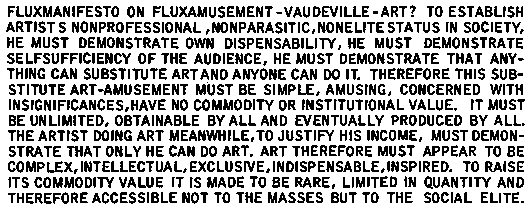This Is Not A Fluxus Page.
|
No sense in doing some bland Wikipedia-esque thing here. Other people have done it better. Still, the point is that I want to make some fair mention of the Fluxus movement as being a sizable influence on a number of aspects of the One Thousand Thousand project. I'm certainly not calling myself a Fluxus artist by any means. [I'm almost not sure if anyone that wasn't involved in the movement when it was first conceived should call themselves a Fluxus artist.] But I'm definitely a Fluxus-inspired artist and I agree entirely with a lot of the principles of Fluxus.
It's pretty hard to put what you feel about something into words when what you feel is genuine passion. When you try to describe why you love your favorite song, for example, you'll probably not do a terrific job and more often than not you'll sound like an idiot. I know I do at least and I'm not chancing that here. I'll leave you with just this stuff and let you find out more about all of this. |
Related Links
|
Fluxus—a name taken from a Latin word meaning "flow, flux" (noun); "flowing, fluid" (adj.)—is an international network of artists, composers and designers noted for blending different artistic media and disciplines in the 1960s.
This art movement began in 1961, it flourished throughout the 1960s, and into the 1970s. Characterized by a strongly Dadaist attitude, Fluxus promoted artistic experimentation mixed with social and political activism, an often celebrated anarchistic change.
Although Germany was its principal location, Fluxus was an international avant-garde movement active in major Dutch, English, French, Swedish, and American cities. Its participants were a divergent group of individualists whose most common theme was their delight in spontaneity and humor.
Fluxus members avoided any limiting art theories, and spurned pure aesthetic objectives, producing such mixed-media works as found poems, mail art, silent orchestras, and collages of such readily available materials as scavenged posters, newspapers, and other ephemera. Their activities resulted in many events or situations, often called "Aktions" — works challenging definitions of art as focused on objects -- performances, guerrilla or street theater and concerts of electronic music.
Although Germany was its principal location, Fluxus was an international avant-garde movement active in major Dutch, English, French, Swedish, and American cities. Its participants were a divergent group of individualists whose most common theme was their delight in spontaneity and humor.
Fluxus members avoided any limiting art theories, and spurned pure aesthetic objectives, producing such mixed-media works as found poems, mail art, silent orchestras, and collages of such readily available materials as scavenged posters, newspapers, and other ephemera. Their activities resulted in many events or situations, often called "Aktions" — works challenging definitions of art as focused on objects -- performances, guerrilla or street theater and concerts of electronic music.
- Fluxus encouraged a “do-it-yourself” aesthetic, and valued simplicity over complexity.
- A strong current of anti-commercialism and an anti-art sensibility, disparaging the conventional market-driven art world in favor of an artist-centered creative practice.
- Fluxus artists preferred to work with whatever materials were at hand, and either created their own work or collaborated in the creation process with their colleagues.


